North Dakota is one of the least populated states in the union, with fewer than a million full time residents. It’s known for dinosaur hunting and bison viewing, along with stunning vistas and mountain biking.
Although the Peace Garden State is too far north to have a lot of snakes, its rugged, sparsely populated terrain is perfect for a few snake species.
Most of North Dakota is uninhabited, giving snakes and other wildlife the ability to live without a lot of human interaction. There are eight confirmed snake species in North Dakota but only one is venomous.
Cold-blooded animals like snakes can’t be active all winter long in cold climates because they need the sun’s heat to support their bodily functions. North Dakota’s snakes are most active between April and late October when the days are warm enough to heat their bodies.
However harsh the environment is for snakes, some have adapted their habits to thrive in it. Here they are!
Garter Snakes
Anywhere you are in North America, garter snakes are probably going to be the most common. North Dakota is no exception. There are two garter snake species in North Dakota. One, the common garter snake is the most cold-tolerant of North American snakes and are often active both earlier and later in the year than other snake species.
Garter snakes are harmless to people, but tend to have a “musk first, ask no questions later” policy. While all snakes can musk, certain species are more prone to the behavior. Musk is horrible-smelling and released from the snake’s cloaca — the same orifice used for waste and mating. Some snakes musk the moment you look at them and try to ward off the threat (you!) with a stinky welcome.
Common Garter Snake (Thamnophis sirtalis ssp.)
The most widespread and versatile of all the garter snakes, common garter snakes and their subspecies are nearly everywhere you’ll find water, moist areas, and amphibians. However, their populations are smaller in North Dakota than in other states.
In North Dakota, you’ll find more red-sided garter snakes (T. s. parietalis) than other common garter snake subspecies; they can grow to three or four feet long. They’re long and thin with somewhat drab colors, except for the yellow to cream dorsal and flank stripes and red vertical bars on either side of their spine.
These snakes eat small amphibians, fish, worms, slugs, and anything else they can overpower and swallow.
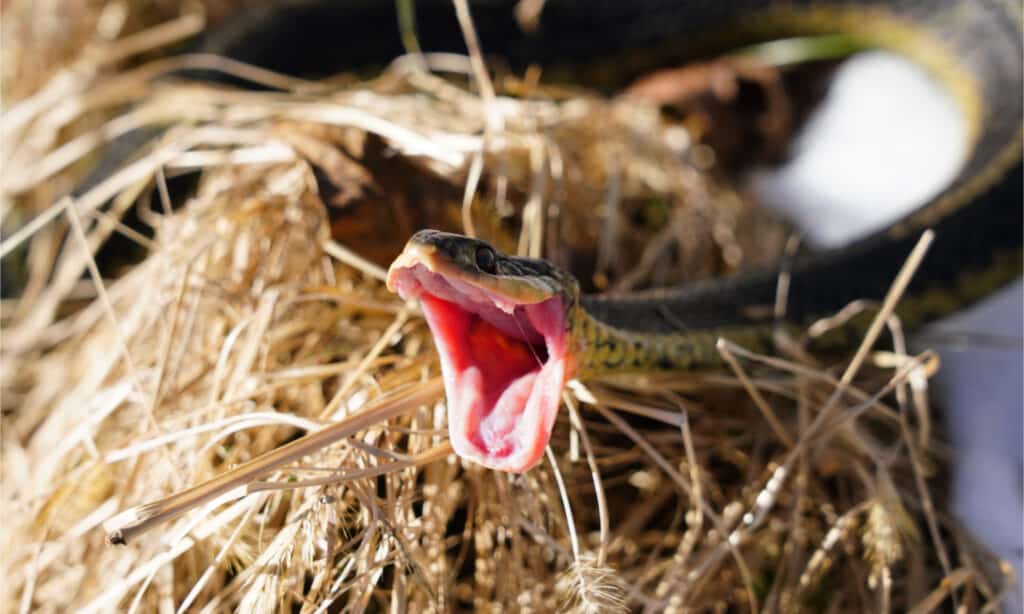
Garter snake venom is harmless to humans but it effectively subdues its prey.
©Aaron of L.A. Photography/Shutterstock.com
Plains Garter Snake (Thamnophis radix)
Another North Dakota native, the plains garter snake is widespread and occurs near the edges of marshes, ponds, and streams — which is fortunate because it also favors amphibians as part of its diet.
Like other garter snakes, plains garter snakes have longitudinal stripes that run down the length of their bodies. However, these snakes have a bright orange or yellow dorsal stripe with white flank stripes. Their flank stripes are often fuzz-edged and a little unclear. Plains garter snakes’ base color can be brownish, greenish, or reddish with two rows of checkerboard markings on either side of their dorsal stripe
Long and thin, plains garter snakes can grow up to three and a half feet long, but most stay smaller.

Plains garter snakes usually have a bright orange or yellow stripe on their back.
©Alyssa Metro/Shutterstock.com
Smooth Green Snake (Opheodrys vernalis)
Another small snake that is native to North Dakota is the Smooth Green snake. These snakes are usually just about a foot and a half long although they can grow up to two feet long. Very shy and nonaggressive, smooth green snakes are harmless to people and mainly eat insects and worms.
Smooth green snakes are bright green color similar to the color of an unripe banana and some have a bit of yellow near the belly scales. As brightly colored as they are, you’d think they’d be easier to spot. However, their color helps them blend into the grass and surface debris where they spend most of their lives.
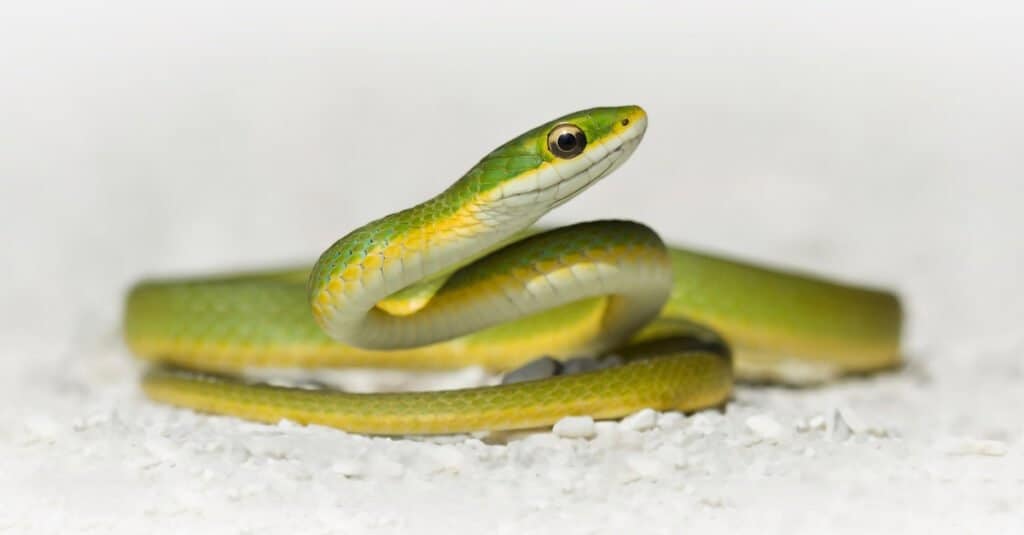
Smooth green snakes are harmless reptiles that eat insects and worms.
©Kristian Bell/Shutterstock.com
North American Racer (Coluber constrictor ssp.)
Racers are long, thin snakes that begin life looking like a young coachwhip, with dorsal blotches that look similar. As they mature, they lose the pattern and become a solid color back with a lighter belly. Most of the various subspecies get their common names from their adult color. North Dakota’s racers vary between gray, blue-green, and brown.
You’re probably not going to see anything except their tail as they zoom away! Racers are fast and don’t want anything to do with you.
Unlike other snakes that calm down after you pick them up, racers don’t seem to have the same ability. They’re often cranky and try to bite you until you release them. Racers eat anything they can overpower, which can mean rodents and birds or even other snakes, including venomous snakes!
Racers are more common in the western half of North Dakota, and often cruise through brush and grasslands, “periscoping” their heads up to see above the grass. They’re curious and sometimes cruise up to people, startling them! However, these harmless snakes take off as soon as they realize you’re too big to eat.

Racers are long and muscular snakes that sometimes prey on other snakes, including venomous species.
©Psychotic Nature/Shutterstock.com
Bullsnake (Pituophis catenifer sayi)
Farmers and ranchers with a rodent problem love it when a bullsnake starts patrolling the area. They’re a gopher snake subspecies that gets pretty big — up to eight feet long! A length which, incidentally, makes them one of the longest snakes in the United States.
These big snakes can look intimidating. Bullsnakes are known for their interesting defense mechanism of puffing themselves up and doing their best rattlesnake imitation. These snakes hiss, rub their body scales against each other (it’s a creepy sound!), and rattle their tail against the ground. Contrary to what the rumors say, all snakes can make their head look bigger when they feel threatened. That triangular shape doesn’t necessarily indicate venomous — just scared.
Bullsnakes can be either gray, light tan, or brown with black or dark brown markings. One identifying feature is a dark brown line over the top of their snout, connecting their eyes. They’re not venomous but they can pack a punch if you’re on the receiving end of a bite. However, they’re more likely to head-butt you with a closed mouth than with an open-mouthed bite.
These nonvenomous colubrids eat various prey that includes rats, mice, voles, ground squirrels, birds, and any small lizards they can grab. Bullsnakes hold and constrict their prey to subdue it and don’t usually swallow it while it’s still kicking.
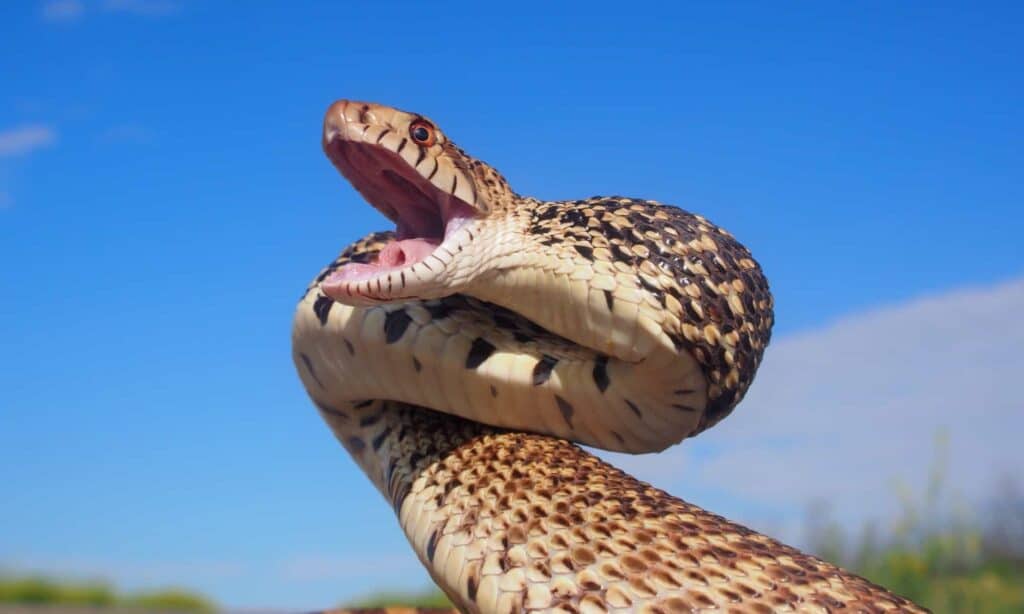
Bullsnakes try to scare you off by mimicking
rattlesnakes
.
©Markparker1983/Shutterstock.com
Plains Hognose Snake (Heterodon nasicus)
The drama noodles of the snake world have a patchy population in North Dakota, with most sightings in the southern and western counties.
Plains hognose snakes are relatively small but muscular for their size, only growing to about two feet long. They have light base colors with darker spots; their pattern is similar enough to rattlesnakes that some people mistake them for venomous snakes — however, they’re harmless to people.
These snakes love loose, sandy soil and use their upturned rostral scale to help them dig in the dirt. Hognose snakes mostly eat toads but will eat other prey in a pinch. However, it’s not their diet that makes them a truly special find — it’s their defensive display.
When threatened, plains hognose snakes start out by spreading a small cobra-like hood and puff themselves up. Except, there aren’t any cobras here, so we’re pretty sure they’re just trying to make themselves look bigger.
If the big, bad, 36-inch snake doesn’t work, they move on to their next act: death feigning. Hognose snakes writhe around on the ground like they’re in agony, slowing down and coming to a stop, belly-up with mouth agape and tongue hanging out.
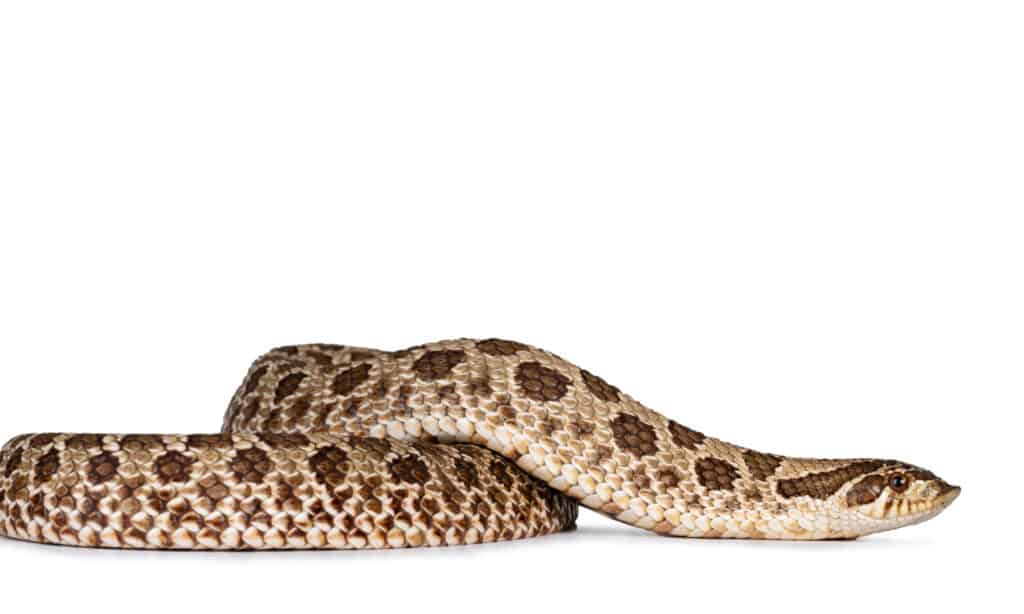
Plains hognose snakes are sometimes confused with rattlesnakes because their patterns can look similar.
©Nynke van Holten/Shutterstock.com
Red-Bellied Snake (Storeria occipitomaculata)
Small slug and worm eaters, red-bellied snakes only grow to about 10 inches long. They spend most of their time hiding under leaf litter, rotten logs, and other moist locations. Red-bellied snakes aren’t aggressive, certainly not venomous, and almost never try to bite when you pick one up.
This species is more common in central to eastern North Dakota and have a wide stripe down their back. Body colors can be gray, brown, reddish, or reddish brown and their bellies are usually bright red, but also pink or orange.
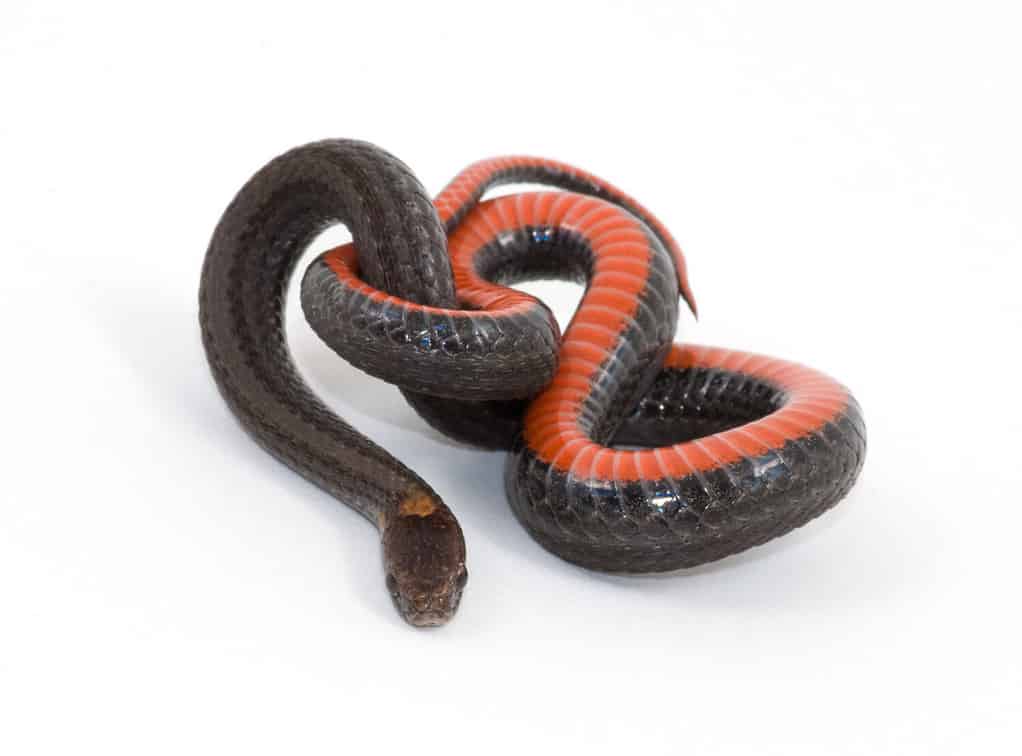
Red-bellied snakes are cousins to Dekay’s brownsnake and frequent many of the same habitats.
©Gerald A. DeBoer/Shutterstock.com
Prairie Rattlesnake In North Dakota
There is only one venomous snake species in North Dakota — the prairie or western rattlesnake. And, it’s not very common in the state. You’ll only encounter them in the southwestern quarter of North Dakota if you encounter one at all.
Prairie Rattlesnakes avoid humans whenever they can. They’re shy snakes, even though the rattling sound may send chills down your spine.
Most prairie rattlesnakes inhabit southwestern North Dakota and prefer grasslands, sagebrush, and sometimes high rocky ledges. These ambush predators wait until their favorite prey, mainly small animals, wanders within striking distance.
All rattlesnakes are venomous. Rattlesnake bites can cause serious injury and sometimes death if they aren’t treated immediately after a bite. According to most sources, their venom contains hemotoxins that damage the blood, but some say there may also be some neurotoxins in their venom.
These distinctive rattlesnakes look like the desert dwellers they are with brown or light brown or gray bodies and darker oval-shaped blotches with white around the edge. Prairie rattlesnakes can grow to a little over five feet, but in North Dakota, they average between three and four.
If you do find yourself face to face with a prairie rattlesnake, you still have time to safely get away. Stop moving immediately, then try to see where the snake is. Once you’ve located the snake, slowly back away from it until you are safely out of the snake’s range. However, you could also freeze and wait for the snake to move — many rattlesnakes will move along, given a chance.

Prairie Rattlesnakes blend perfectly into their habitat.
©Max Allen/Shutterstock.com
Venomous Snakebite First Aid
While it’s unlikely you’ll be bitten by a venomous rattlesnake in North Dakota, knowing what to do can save lives or extremities. Prairie rattlesnakes aren’t known for being as nervous as western diamondback rattlesnakes, however, bites do happen.
According to the Mayo Clinic, here is more information on how to handle a prairie rattlesnake bite.
- Get away from the snake. This may be obvious, but you never know!
- Do NOT capture the snake. From a safe distance, either take photos or memorize details.
- Keep calm. Getting upset and frightened only makes your heart pump the venom through your body faster, increasing the damage.
- Remove all jewelry, watches, and tight-fitting clothing. Nobody wants to cut that stuff off, and it can cut off circulation and cause more damage.
- If possible, place the bite location BELOW the level of your heart.
- Wash with soap and water, then place a clean bandage over the bite.
- Get to a hospital.
They also note a few things you should NEVER do with rattlesnake bites:
- Don’t use tourniquets or ice.
- Don’t drink caffeine or alcohol because it thins the blood and speeds the absorption of venom.
Snakes In North Dakota
You have to be a rugged individual to thrive in the wilderness of North Dakota. It’s not the right environment for everyone. Here’s the complete list of all the snakes in North Dakota.
Some sources mention the western milksnake and the western terrestrial garter snakes as being present in North Dakota. However, according to Amphibians and Reptiles of North Dakota, they’re actually on the list of, “We think it’s possible that there might be a population but we’re not sure.”
| Snake Species | Venomous? |
|---|---|
| Prairie Rattlesnake | Yes! Medical care required. |
| Plains Garter Snake | No |
| Common Garter Snake | Mildly; not medically significant |
| North American Racer | No |
| Smooth Green Snake | No |
| Red-Bellied Snake | No |
| Bullsnake | No |
| Plains Hognose Snake | Mildly; not medically significant |
The photo featured at the top of this post is © Max Allen/Shutterstock.com
Discover the "Monster" Snake 5X Bigger than an Anaconda
Every day A-Z Animals sends out some of the most incredible facts in the world from our free newsletter. Want to discover the 10 most beautiful snakes in the world, a "snake island" where you're never more than 3 feet from danger, or a "monster" snake 5X larger than an anaconda? Then sign up right now and you'll start receiving our daily newsletter absolutely free.
Thank you for reading! Have some feedback for us? Contact the AZ Animals editorial team.







